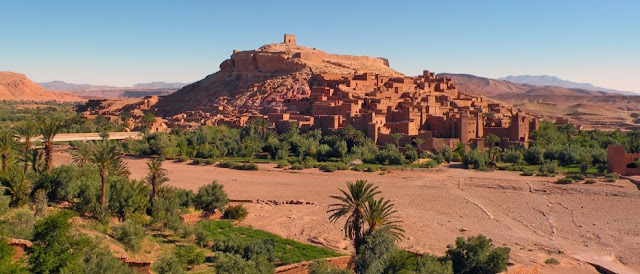Afares, a complicated oak of North Africa
 |
| Airt Ben Haddu, Morocco (© ASA) |
Today, though, I want to drop to the southern side of the Mediterranean, into Africa. Eight oak species growing naturally in northern Africa, with all but one of these found on both the European and African sides of the Mediterranean Sea.
The eight species seem to be split neatly into four from the subgenus Cerris (including the ballota oak, Quercus rotundifolia - sometimes considered part of the holy/holm oak, Quercus ilex - and the cork oak, Quercus suber) and four from the subgenus Quercus (including the Algerian oak, Quercus canariensis).
 |
| Flore de L’Afrique du Nord (1961), Volume 7, Figure 1156: Quercus Afares |
I say 'seem' because you could also say there are four and a half species in one subgenus and three and a half in the other. That half/half species is the Afares oak (Quercus afares).
It is the only one of the eight species with a natural distribution that doesn’t cross the Mediterranean. Today there is a single population in Tunisia and several in Algeria, but it remains insecure across its range and has been listed as threatened with extinction.
The Afares oak was described and named as a new species in 1874, from the Tell Atlas Mountains in coastal Algeria, between Béjaïa and Jijel. Not far from Algiers, which is one of the places on Earth with a climate today like we are likely to experience in Melbourne by 2090. So a good place to search for future tree plantings.
I can’t track down the origin of the species name afares, but I want it to be somehow derived from the Latin word for African, afer, the name of the local people of Carthage during Roman times, in current day Tunisia. More likely, it is from Afar, the people and language spoken in the region now included within Ethiopia, Eritrea and Djibouti (the latter once a French territory, first called French Somaliland and for a short time, Afars and the Issas), even though that doesn’t fit with the known distribution of the Afares oak today.
The botanist who devised the name Quercus afares, Nicolas Auguste Pomel, was French (born in France and in 1851 deported to Algiers, where he practiced as a mines engineer while pursuing interests in fossil elephants and rhinoceros, as well as living plants), so let’s assume it’s some kind of misdirected evocation of North Africa.
 |
| Qasba of Taourirt, Ouarzazate (Visual Hunt; © ASA) |
For historical reasons I think, the Afares oak is filed away in the subgenus Cerris. After all it was first considered to be a chestnut-leaved oak, which belongs that subgenus, as does one of its demonstrated ‘parent species’, the cork oak.
It also looks more like the chestnut-leaved oak and another member of the subgenus Cerris, the Turkey oak. I suppose you could leave it there but also give it honorary status as a member of the subgenus Quercus, which is where the Algerian oak is placed. That is the half/half solution.
Our classification systems do not cope well with such intricacies. While the rest of the African species seem simpler to classify, perhaps that’s only because we don’t know the full story.
 |
| Roman ruins, Volubilis (© ASA) |
One of those species grown for ornament in southern Africa is the Algerian oak, from North Africa and the Iberian Peninsula. It too has an interesting taxonomic back story, associated with its misleading botanical name Quercus canariensis. Another day.
* * *
Note: Because I don't have any photographs of the Afares oak, apart from the black and white illustration from Flore de L’Afrique du Nord, the images included here are landscapes in Morocco. Not because the Afares oak grows there - it doesn't - but because the Atlas Mountains in Morocco are home to the Algerian and ballota oaks, and ... because I'm leading a tour to this country in 2025 with ASA Cultural Tours: 'Spectacular Landscapes, Gardens, Imperial Cities & Kasbahs of Morocco 2025'. The Moroccan images are taken from the ASA website.

Comments